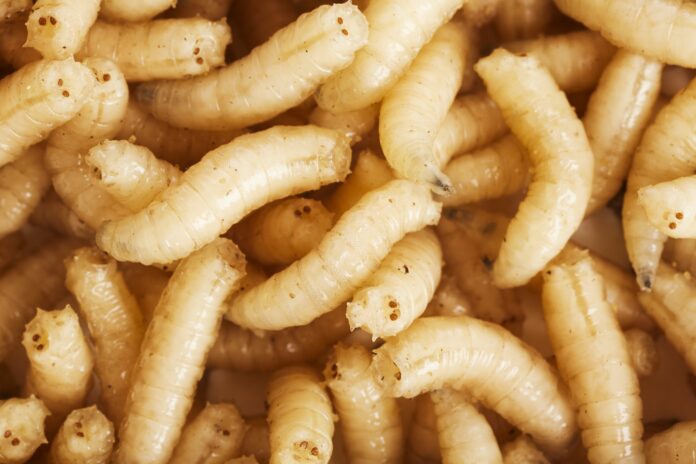A maggot is a larva of the common fly. Maggots have soft bodies and no legs, so they look a bit like worms. They usually have a reduced head that can retract into the body. Maggot commonly refers to larvae that live on rotting flesh or tissue debris of animal and plants. Some species eat healthy animal tissue and living plant matter.
Why would you eat them?
Some people choose to eat maggots intentionally. Maggots may be fried and eaten in places where eating bugs is commonplace. They can also be used to make a Sardinian delicacy. “Casu marzu” translates to maggot cheese or rotten cheese. It’s an Italian cheese that’s prepared specially to turn into breeding grounds for maggots. While casu marzu may be described as a fermented Pecorino cheese, it’s actually decomposing. It’s said that the cheese is safe to eat as long as the maggots are still living.
It’s also possible to eat maggots by mistake since they’re often found around food, though usually they’re found around contaminated food that you’d avoid. However, eating maggots poses a few risks of which you need to be aware.
Risks of eating maggots
It may be safe to consume maggots themselves, but you may be susceptible to whatever they’ve eaten or been exposed to, such as feces or rotting flesh. Fruit infested with maggots is likely to be rotting and ridden with bacteria. Other risks include the following:
Myiasis
Myiasis is an infection that occurs when maggots infest and feed on the living tissue of animals or humans. It’s most common in tropical and subtropical counties. People who have difficulty maintaining good oral hygiene are particularly at risk. Larvae can settle in areas of the mouth where hygiene is poor.
Eating maggots is also thought to leave the internal organs and tissue susceptible to the larvae, although myiasis is more commonly something that occurs under the skin. The maggots that cause myiasis can live in the stomach and intestines as well as the mouth. This can cause serious tissue damage and requires medical attention.
Myiasis is not contagious. Symptoms of myiasis in your gastrointestinal tract include stomach upset, vomiting, and diarrhea. In the mouth, the larvae are typically visible.
Bacterial poisoning
Eating maggots or maggot-infested food can cause bacterial poisoning. Most foods that have maggots aren’t safe to eat, especially if the larvae have been in contact with feces. Some houseflies use animal and human feces as breeding sites. They also breed on garbage or rotting organic material.
It’s possible for maggots to become contaminated with Salmonella enteritidis and Escherichia coli bacteria. Symptoms of an E. coli infection include fever, diarrhea, nausea or vomiting, and cramping. Symptoms of salmonella are similar. Both conditions can also cause bloody stool and fatigue.
Allergic reaction
Some people may be allergic to maggots. Certain types of larvae have been shown to cause respiratory and asthmatic symptoms in people who handled the larvae to use as live fishing bait or who are occupationally exposed. Contact dermatitis has also been reported.
It’s been suggested that you may have an allergic reaction if you eat larvae that have been exposed to or consumed foods you’re allergic to. Scientific research is needed to clarify this view.
Is there a way to safely eat maggots?
Maggots may be a viable source of protein, good fats, and trace elements. Scientists are looking into the possibility of using maggots to produce textured protein or a sustainable snack for humans.
Eating dried, cooked, or powdered maggots is safer than eating whole, unprocessed larvae. The processing would get rid of microbes, parasites, and bacterial spores. Producing larvae in this way would have less of an environmental impact than producing meat for human consumption.
However, at present, risks still exist and likely outweigh potential benefits.
When to see a doctor
Call your doctor if you develop any unusual symptoms that you think are related to eating maggots. This is especially important if you’re in the tropics or traveling in a country with unsafe food conditions.
Source: www.healthline.com










